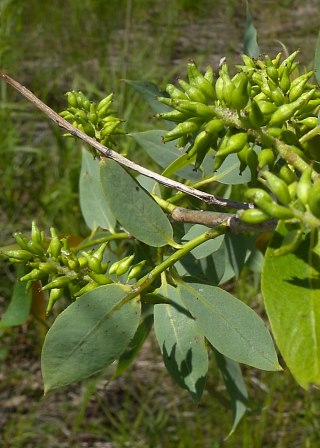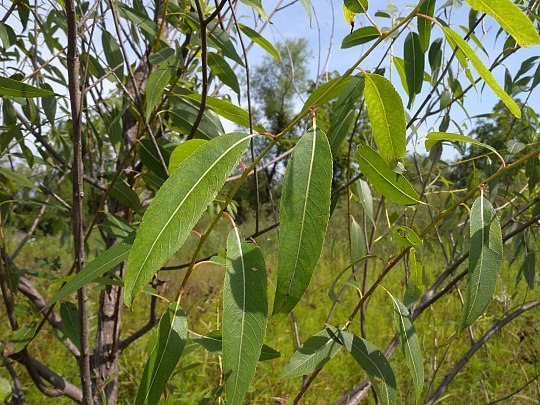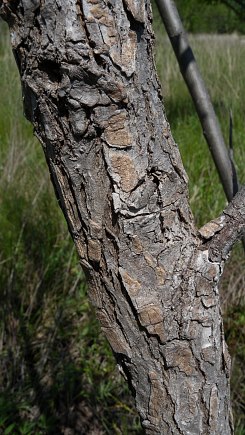Description: This tree is up to 70' tall, usually forming a single trunk up to 2' wide and a rounded to slightly elongated crown. The rough bark of the trunk is brownish gray, shallowly furrowed, and somewhat scaly. Large branches are ascending, while smaller branches are widely spreading or slightly drooping. The gray bark of the branches is smooth to slightly rough. Young twigs are smooth and brown, while new shoots are green and glabrous. Alternate leaves occur along the twigs and new shoots. These leaves are up to 5" long and ¾" across (rarely larger); they are narrowly lanceolate to ovate and finely serrated along their margins. The upper surfaces of mature leaves are medium green and glabrous, while their lower surfaces are pale whitish green, glabrous, and often slightly glaucous. Additionally, the lower leaf surfaces are flat, lacking raised veins. The slender petioles of mature leaves are about ½" long, light green to nearly red, and hairless. Young leaves are often reddish and less often pubescent, but these characteristics disappear with age. At the base of the petioles, stipules are absent, or insignificant and early-deciduous.

Peach-Leaved Willow is dioecious, forming male and female catkins (aments) on separate trees. Both male and female catkins develop from short lateral branches; both types of catkins are erect to widely spreading. Male catkins are 1-2" long and cylindrical in shape, consisting of many male florets. Female catkins are 2-4" long and narrowly cylindrical in shape, consisting of ascending to widely spreading female florets. Each male floret consists of 3-5 stamens; it is short-hairy toward the base of its stamens. Each female floret consists of a narrowly pear-shaped ovary (roughly lanceoloid); it is 3-4 mm. long, green and glabrous. At the base of each female floret, there is a slender pedicel about 1.5–2.5 mm. long. The blooming period occurs from mid- to late spring and lasts about 2 weeks. The male florets wither away, while the ovaries of the female florets develop into seed capsules. At maturity, these capsules turn brown and split open, releasing tiny seeds with tufts of hair that are distributed by the wind. The root system is shallow, woody, and branching. This tree reproduces by reseeding itself.

Cultivation: The preference is full or partial sun, wet to moist conditions, and soil that is loamy, silty, or slightly sandy. This tree is fast-growing, but short-lived. Temporary flooding is tolerated.
Range & Habitat: The native Peach-Leaved Willow is occasional in the northern and western halves of Illinois, while in the SE section of the state it is uncommon or absent (see Distribution Map). Peach-Lived Willow is a typical riverbank species in the Northern Plains. Habitats include bottomland woodlands, swamps, borders of rivers and ponds, and transition zones between bottomland woodlands and riverbottom prairies. Peach-Lived Willow is a pioneer species of damp open areas that are often located near bodies of water.
 Faunal Associations: The nectar and pollen of the florets attract honeybees, cuckoo bees (Nomada spp.), little carpenter bees (Ceratina spp.), Halictid bees (including green metallic bees), spider wasps (Pompilidae), Vespid wasps, sawflies, Syrphid flies, dance flies (Empididae), thick-headed flies (Conopidae), Muscid flies, and other flies. Among the Andrenid bees, several of them are oligoleges (pollinator specialists) of Peach-leaved Willow and other willows (Salix spp.): Andrena andrenoides, Andrena bisalicis, Andrena erythrogaster, Andrena illinoiensis, Andrena mariae, Andrena salictaria, and Andrena sigmundi (Robertson, 1929; Krombein et al., 1979). Other insects feed destructively on the foliage, wood, plant juices, catkins, and other parts of willows. These species include the larvae of metallic wood-boring beetes, larvae of long-horned beetles, leaf beetles, weevils, larvae of leaf-mining flies, larvae of gall flies, plant bugs, stink bugs, aphids, spittlebugs, leafhoppers, armored scales, larvae of Argid sawflies, larvae of common sawflies (Tenthredinidae), larvae of Tiger moths (Arctiidae), larvae of Geometer moths, larvae of leaf blotch miner moths (Gracillariidae), larvae of slug caterpillar moths (Limacodidae), larvae of hairstreak butterflies (Satyrium spp.), larvae of Lyonet moths, larvae of owlet moths (Noctuidae), larvae of prominent moths (Notodontidae), larvae of brush-footed butterflies (Limenitis spp., Nymphalis spp.), larvae of giant silk moths (Saturniidae), larvae of Sphinx moths, larvae of Tortrix moths, and thrips. The Insect Table provides a more complete list and detailed list of these insect feeders. Various birds use willows as a source of food, protective habitat, and nest sites. These bird species include the Wood Duck, Northern Pintail, Mallard, Common Redpoll, Evening Grosbeak, Pine Grosbeak, American Goldfinch, Common Grackle, Ruffed Grouse, Red-bellied Woodpecker, and Red-headed Woodpecker. The Bird Table provides more information about this. Among mammals, the American Moose and White-tailed Deer browse on the foliage and twigs. The American Beaver gnaws on both the bark and wood of willows, while the Muskrat and Cottontail Rabbit gnaw on only the bark. The American Black Bear, Fox Squirrel, Meadow Vole, and Prairie Vole feed on the leaves, buds, and/or catkins of these shrubs and trees (Martin et al., 1951/1961; Hamerstrom & Blake, 1939; Romain et al., 2013). The Snapping Turtle and Wood Turtle feed on the fallen leaves (Ernst et al., 1994; Lagler, 1943). Beavers often use the branches of willows to construct their lodges and dams.
Faunal Associations: The nectar and pollen of the florets attract honeybees, cuckoo bees (Nomada spp.), little carpenter bees (Ceratina spp.), Halictid bees (including green metallic bees), spider wasps (Pompilidae), Vespid wasps, sawflies, Syrphid flies, dance flies (Empididae), thick-headed flies (Conopidae), Muscid flies, and other flies. Among the Andrenid bees, several of them are oligoleges (pollinator specialists) of Peach-leaved Willow and other willows (Salix spp.): Andrena andrenoides, Andrena bisalicis, Andrena erythrogaster, Andrena illinoiensis, Andrena mariae, Andrena salictaria, and Andrena sigmundi (Robertson, 1929; Krombein et al., 1979). Other insects feed destructively on the foliage, wood, plant juices, catkins, and other parts of willows. These species include the larvae of metallic wood-boring beetes, larvae of long-horned beetles, leaf beetles, weevils, larvae of leaf-mining flies, larvae of gall flies, plant bugs, stink bugs, aphids, spittlebugs, leafhoppers, armored scales, larvae of Argid sawflies, larvae of common sawflies (Tenthredinidae), larvae of Tiger moths (Arctiidae), larvae of Geometer moths, larvae of leaf blotch miner moths (Gracillariidae), larvae of slug caterpillar moths (Limacodidae), larvae of hairstreak butterflies (Satyrium spp.), larvae of Lyonet moths, larvae of owlet moths (Noctuidae), larvae of prominent moths (Notodontidae), larvae of brush-footed butterflies (Limenitis spp., Nymphalis spp.), larvae of giant silk moths (Saturniidae), larvae of Sphinx moths, larvae of Tortrix moths, and thrips. The Insect Table provides a more complete list and detailed list of these insect feeders. Various birds use willows as a source of food, protective habitat, and nest sites. These bird species include the Wood Duck, Northern Pintail, Mallard, Common Redpoll, Evening Grosbeak, Pine Grosbeak, American Goldfinch, Common Grackle, Ruffed Grouse, Red-bellied Woodpecker, and Red-headed Woodpecker. The Bird Table provides more information about this. Among mammals, the American Moose and White-tailed Deer browse on the foliage and twigs. The American Beaver gnaws on both the bark and wood of willows, while the Muskrat and Cottontail Rabbit gnaw on only the bark. The American Black Bear, Fox Squirrel, Meadow Vole, and Prairie Vole feed on the leaves, buds, and/or catkins of these shrubs and trees (Martin et al., 1951/1961; Hamerstrom & Blake, 1939; Romain et al., 2013). The Snapping Turtle and Wood Turtle feed on the fallen leaves (Ernst et al., 1994; Lagler, 1943). Beavers often use the branches of willows to construct their lodges and dams.
Photographic Location: A prairie swale at Meadowbrook Brook in Urbana, Illinois.
Comments: This is one of the larger willows in Illinois, although shrub-sized specimens are often encountered. The attractive leaves are rather variable in size and shape, even on the same tree. Distinguishing Peach-Leaved Willow from other species in this genus is rather difficult, but it has the following key characteristics: 1) it lacks persistent stipules, 2) mature leaves are hairless and pale underneath, although not whitened, 3) the ovaries of female florets are 3-4 mm. long, hairless, and narrowly pear-shaped, 4) the pedicels underneath the ovaries are relatively long (about 2 mm.), and 5) the male florets have 3-5 stamens. Unless the florets of female or male catkins can be examined, the identification of this willow is rather problematic.